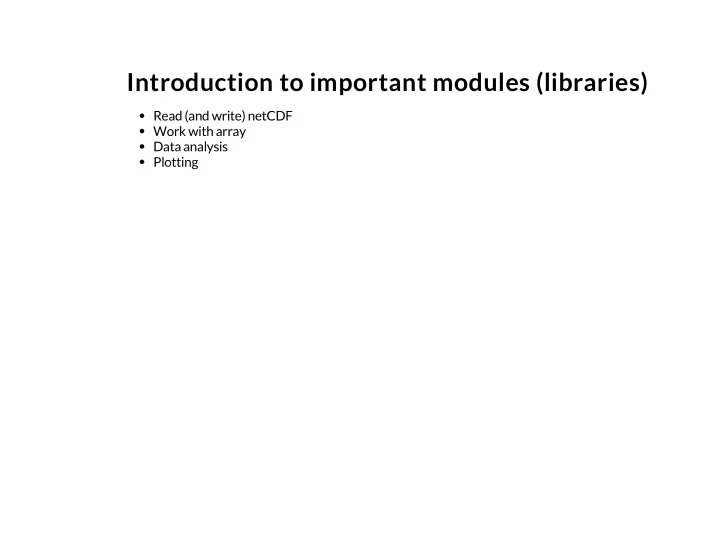

Introduction to important modules (libraries) Read (and write) netCDF Work with array Data analysis Plotting
Read (and write netCDF) The netCDF4 module
Read a netCDF In [3]: # import the module import netCDF4 In [4]: # open the netCDF file ncfile = netCDF4.Dataset(filename) In [5]: # get global attributes print ncfile.ncattrs() [u'CDI', u'Conventions', u'history', u'source', u'institution', u'title', u'project_id' , u'experiment_id', u'realization', u'conventionsURL', u'contact', u'references', u'ncc f_version', u'creation_date', u'CDO'] In [6]: # get the variables print type(ncfile.variables) print ncfile.variables.keys() <class 'collections.OrderedDict'> [u'lon', u'lat', u'lev', u'time', u'time_bnds', u'vcoord', u'HHL', u'HSURF', u'FIS', u' FC', u'RLAT', u'RLON', u'FR_LAND', u'SOILTYP', u'VIO3', u'HMO3', u'PLCOV', u'LAI', u'RO OTDP'] In [7]: # close the file ncfile.close()
Write a netCDF In [9]: # open the dataset, r+ indicate read and write rights ncfile = netCDF4.Dataset(filename, 'r+') # or 'w' # create a new dimension ncfile.createDimension('newdim', 1) # create a new variable ncfile.createVariable('newvar', 'f8', ('newdim', )) # save the changes ncfile.sync() # close the files ncfile.close()
Manipulate data using array/matrix The numpy module Homogeneous multidimensional array It is a table of elements (usually numbers), all of the same type, indexed by a tuple of positive integers. In Numpy dimensions are called axes. [http://wiki.scipy.org/Tentative_NumPy_Tutorial]
Basics In [11]: # load the module import numpy as np In [12]: # create a 3x2 array of zeros array = np.arange(6).reshape(3, 2) print array [[0 1] [2 3] [4 5]] In [13]: print array.shape (3, 2) In [14]: print array.size 6 In [15]: print array.ndim 2
Create Array print np.array([10,20,30]) In [16]: [10 20 30] In [17]: print np.array([[10, 20, 30], [1, 2, 3]]) [[10 20 30] [ 1 2 3]] In [18]: print np.arange(0, 10, 1) [0 1 2 3 4 5 6 7 8 9] In [19]: print np.linspace(0,10,11) [ 0. 1. 2. 3. 4. 5. 6. 7. 8. 9. 10.] In [20]: print np.zeros((10,10)) # or use empty() or ones() [[ 0. 0. 0. 0. 0. 0. 0. 0. 0. 0.] [ 0. 0. 0. 0. 0. 0. 0. 0. 0. 0.] [ 0. 0. 0. 0. 0. 0. 0. 0. 0. 0.] [ 0. 0. 0. 0. 0. 0. 0. 0. 0. 0.] [ 0. 0. 0. 0. 0. 0. 0. 0. 0. 0.] [ 0. 0. 0. 0. 0. 0. 0. 0. 0. 0.] [ 0. 0. 0. 0. 0. 0. 0. 0. 0. 0.] [ 0. 0. 0. 0. 0. 0. 0. 0. 0. 0.] [ 0. 0. 0. 0. 0. 0. 0. 0. 0. 0.] [ 0. 0. 0. 0. 0. 0. 0. 0. 0. 0.]]
Basic Operations In [21]: array = np.arange(6).reshape(3,2) b = array + 12 print b [[12 13] [14 15] [16 17]] In [22]: print b.min() print b.max() 12 17 In [23]: print b - array [[12 12] [12 12] [12 12]] In [24]: print 10 * np.sin(b) [[-5.36572918 4.20167037] [ 9.90607356 6.5028784 ] [-2.87903317 -9.61397492]] In [25]: print b.mean(axis=1) [ 12.5 14.5 16.5]
Slicing and indexing In [26]: a = np.arange(10)**3 print a [ 0 1 8 27 64 125 216 343 512 729] In [27]: print a[2], a[2:5] print a[::-1] 8 [ 8 27 64] [729 512 343 216 125 64 27 8 1 0] In [28]: a[:6:2] = - 1000 print a [-1000 1 -1000 27 -1000 125 216 343 512 729] In [29]: a.shape = (5,2) print a[:, 0] [-1000 -1000 -1000 216 512] In [30]: print a[2:4, -1] [125 343] In [31]: a.shape = (2, 1, 5) print a[1, ...] [[125 216 343 512 729]]
Data analysis The scipy module
module description cluster Clustering algorithms constants Physical and mathematical constants fftpack Fast Fourier Transform routines integrate Integration and ordinary differential equation solvers interpolate Interpolation and smoothing splines io Input and Output linalg Linear algebra ndimage N-dimensional image processing odr Orthogonal distance regression optimize Optimization and root-finding routines signal Signal processing sparse Sparse matrices and associated routines spatial Spatial data structures and algorithms special Special functions stats Statistical distributions and functions weave C/C++ integration
Small example In [32]: from scipy import integrate In [33]: integrate.trapz([1,2,3]) 4.0 Out[33]: In [34]: integrate.trapz([1,2,3], x=[4,6,8]) 8.0 Out[34]:
Plotting The matplotlib module based on http://www.loria.fr/~rougier/teaching/matplotlib/
In [36]: # import the module import matplotlib.pyplot as plt In [37]: X = np.linspace(-np.pi, np.pi, 256,endpoint=True) C,S = np.cos(X), np.sin(X) In [39]: plt.plot(X,C); plt.plot(X,S);
In [41]: fig = plt.figure(figsize=(20,10), dpi=150) plt.plot(X, C, color="red", linewidth=2.5, linestyle="-") plt.plot(X, S, "-b", linewidth=2.5);
In [43]: plt.xticks( [-np.pi, -np.pi/2, 0, np.pi/2, np.pi]); plt.yticks([-1, 0, +1]);
In [45]: plt.xticks([-np.pi, -np.pi/2, 0, np.pi/2, np.pi], [r'$-\pi$', r'$-\pi/2$', r'$0$', r'$+\pi/2$', r'$+\pi$']); plt.yticks([-1, 0, +1], [r'$-1$', r'$0$', r'$+1$']);
In [47]: ax = plt.gca() ax.spines['right'].set_color('none') ax.spines['top'].set_color('none') ax.xaxis.set_ticks_position('bottom') ax.spines['bottom'].set_position(('data',0)) ax.yaxis.set_ticks_position('left') ax.spines['left'].set_position(('data',0))
In [50]: t = 2*np.pi/3 plt.plot([t,t],[0,np.cos(t)], color ='red', linewidth=2.5, linestyle="--") plt.scatter([t,],[np.cos(t),], 50, color ='red') plt.annotate(r'$\sin(\frac{2\pi}{3})=\frac{\sqrt{3}}{2}$', xy=(t, np.sin(t)), xycoords='data', xytext=(+10, +30), textcoords='offset points', fontsize=24, arrowprops=dict(arrowstyle="->", connectionstyle="arc3,rad=.2")) plt.plot([t,t],[0,np.sin(t)], color ='blue', linewidth=2.5, linestyle="--") plt.scatter([t,],[np.sin(t),], 50, color ='blue') plt.annotate(r'$\cos(\frac{2\pi}{3})=-\frac{1}{2}$', xy=(t, np.cos(t)), xycoords='data', xytext=(-110, -50), textcoords='offset points', fontsize=24, arrowprops=dict(arrowstyle="->", connectionstyle="arc3,rad=.2"));
In [52]: for label in ax.get_xticklabels() + ax.get_yticklabels(): label.set_fontsize(24) label.set_bbox(dict(facecolor='white', edgecolor='None', alpha=0.65 ))
Plotting on a map The basemap module
In [54]: from mpl_toolkits.basemap import Basemap m = Basemap(llcrnrlon=-100.,llcrnrlat=20.,urcrnrlon=20.,urcrnrlat=60, resolution='l', projection='merc',lat_0=40.,lon_0=-20.,lat_ts=20.) In [61]: # lon / lat of New York and London (nylat, nylon), (lonlat, lonlon) = (40.78, -73.98), (51.53, 0.08), # draw great circle route between NY and London m.drawgreatcircle(nylon,nylat,lonlon,lonlat,linewidth=2,color='b') m.drawcoastlines() # draw parallels m.drawparallels(np.arange(10,90,20),labels=[1,1,0,1]) # draw meridians m.drawmeridians(np.arange(-180,180,30),labels=[1,1,0,1]) plt.title('Great Circle from New York to London') topo = m.etopo()
Other plotting possibilities (some will be used in the next exercise) In []: m.plot m.contour m.contourf m.scatter m.barbs m.quiver
Question ?
Recommend
More recommend